Q&A with Historic Richmond Town's Broom Maker
by Marketing & Communications Intern Olivia Medina
HRT’s resident broom maker and historical interpreter, Ian Hagens, gives us a behind the scenes look at one of the historic trades to be practiced daily during our Open Village season beginning May 25.
What originally made you interested in learning the broom-making trade at Historic Richmond Town?
I was asked if I would be interested in helping the development of a new trade for Historic Richmond Town and was immediately interested in the process. I have some experience working with weaving in our Basket Maker’s shop and it was very rewarding seeing those same skills be put to good use while developing the new skills needed for broom-making.
Can you explain the basics of the broom-making process?
Broom-making combines a few different skill sets that can be found in other historic trades; those skills being binding, weaving and stitching. The most simple explanation of broom-making is attaching bristly material to the end of a pole that acts as a handle. How you go about attaching materials and choosing what materials is what makes the process of making brooms so fun.
Can you give us a bit of background on the history of broom making in early America?
Broom-making has a very long history here in America and globally. The materials, tools and techniques we use in our workshop represents a broom-makers shop that's working in the early 1800s and onward. We use a long bristley stalk from a broom corn plant as our sweeping material and this was a broom innovation from the early 1800’s when Shaker farmers discovered its effectiveness as a sweeping material. From there broom corn brooms exploded in popularity.
Is every broom the same or are there different kinds?
Since starting in the broom-maker’s workshop last year I have found that no two brooms are the same. There are small differences in each of the brooms I have made. We’re trying to make our brooms as uniform as possible which is not always possible when it comes to the materials we use and the variations of stylistic choices we have on hand when making the broom.
What has been your favorite part about demonstrating broom making to the public?
I love taking a domestic tool that is so often overlooked in our homes and giving it the limelight in our shop. There is so much cool history on the materials we use, the people who made them, and the way in which they were used. I love the questions people ask me when I have piqued their interest in a certain aspect of broom-making.
Are there any opportunities for people to learn the art of historical broom making at HRT?
There are opportunities to learn this trade at Richmond Town! We offer an apprenticeship program in the summer where those interested in making a broom can take part in the craft and learn how to bind, weave and stitch their own broom. They'll get the opportunity to create their very own broom and bring that home with them.
Visit Ian and watch him in action starting May 25, every Wednesday-Sunday in our main village!





